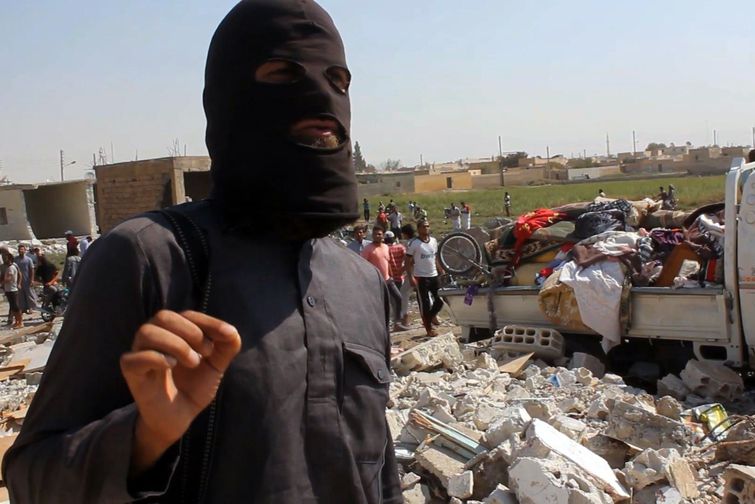
As if the Syria and Iraq conflicts weren't bad enough, here's some more alarming news: the influx of foreign fighters, which is to say foreigners volunteering to fight for Sunni militant groups such as ISIS or al-Qaeda, has reached an all-time high: as many as 20,000. According to a new estimate from the International Center for the Study of Radicalisation and Political Violence(ICSR), no conflict since 1945 has ever attracted this many foreign fighters.
That's a real problem — and not just for Iraq and Syria. Some of these fighters will likely go on to attempt to plot international terrorist attacks; others to travel from war to war, making each of those bloodier in turn, much as the foreigners who fought against the Soviet Union in Afghanistan in the 1980s went on to cause trouble for a generation.
According to the ICSR report, up to 20,730 people have gone to fight for Sunni militant groups in Syria and Iraq. Emphasis on "up to:" ICSR's report contains a range, and the 20,730 figure comes from adding all of the high-end estimates together. Using low-end estimate comes out to around 16,700. These estimates come from collating and comparing government figures, media reports, and statements from the militant groups themselves.
Still, that number already matches or even exceeds credible high-end estimates for the number of foreigners who went to fight against the 1979 Soviet invasion of Afghanistan (about 20,000 foreign fighters). Until now, that conflict had attracted more foreign fighters than any other since 1945. And the wars in Syria and Iraq are very far from over.
/cdn0.vox-cdn.com/uploads/chorus_asset/file/3343072/Screen_Shot_2015-01-26_at_2.48.45_PM.0.png)
Abu Umar al-Shishani, a Chechen national who has led ISIS forces in western Iraq. (ISIS)
According to Peter Neumann, ICSR's director, it's very hard to know what happens to these people after their initial arrival in Iraq or Syria. The 20,370 number refers to the total number who have ever fought in Syria or Iraq; many may already be dead or back in their home countries. Neumann does believe that the overwhelming bulk of these fighters fought, at least at one point, either for ISIS or for Jabhat al-Nusra, al-Qaeda's Syrian branch.
These fighters "have completely absorbed [radical] ideology, and see themselves more-or-less as fighters," Neumann says. "What happened after the Afghanistan conflict in the 1980s was an internationally networked core of activists who were seeing themselves as a rapid reaction force to whatever happened in the Muslim world."
That post-Afghanistan network included al-Qaeda as we know it today.
Broadly speaking, this sort of international network of Syria and Iraq veterans poses two kinds of threats. First, they might go back to their home countries — predominantly in the Middle East, with contingents in Western Europe and the former Soviet Union — and attempt terrorist attacks. Second, they could travel from war to war in the Muslim world, making each conflict worse as they go.
The majority of fighters who return home will not commit terrorist attacks. According to Neumann, the highest-end estimate suggests 25 percent will plan attacks back home. One estimate from September suggested that less than one percent of Western European foreign fighters in Syria and Iraq had, to date, gotten involved in terrorism. Countries with strong security services, like those in Western Europe, are particularly well-positioned to foil plots.
Nevertheless, the threat from returnees is real. Attacks planned by foreign fighters "tend to be [among] the more lethal and more viable terrorist plots," Neumann says, because foreign fighters have "military training, motivation, and an international [support] network." Moreover, some countries may be more threatened by foreign fighters than others. For example, an estimated 1,500 to 3,000 of the fighters are from Tunisia, a young democracy and the Arab Spring's big success story.
"There is a very strong recruitment network of Salafist organizations that send people from Tunisia to Syria or Iraq," Neumann says. "In the long term, [Tunisia] is facing a big challenge of people coming from back from Syria and Iraq. Perhaps one of the reason's it's so peaceful there is that all of the troublemakers are in a different place."
However, a fair number of foreign fighters will never come home. That shouldn't be comforting: many of those people will simply become permanent warriors, flitting from hot spot to hot spot and leaving chaos in their wake.
"Quite a few them ... will prefer to move on to the next battlefront," Neumann says. If and when the Syria and Iraq conflicts end or slow down, "I would expect quite a few of them to want to move to Libya, maybe to Yemen, or maybe back to Afghanistan."
These fighters will almost certainly make these conflicts bloodier and more chaotic. According to Neumann, foreign fighters are extreme even by jihadi standards. "They are typically people who are not invested in a local situation ... they often see the conflict in very ideological terms," Neumann says,
In his view, that makes them more likely to commit atrocities. That invites counter-atrocities, and can polarize local conflicts on ethno-sectarian lines.
"There foreign fighters do make a conflict worse," Neumann says. "Whatever conflict you look at in the 1990s and 2000s — [like] Bosnia or Chechnya — once the foreign fighters come in, it turns nasty."
- FILED UNDER:
- Syrian Civil War,
- World and Defense

No comments:
Post a Comment